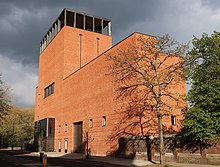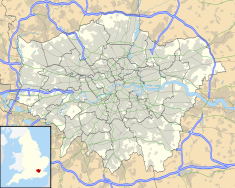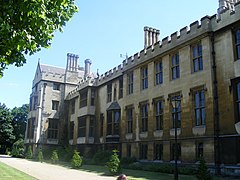Lambeth Palace
| Lambeth Palace | |
|---|---|
See of Canterbury | |
Listed Building – Grade I | |
| Official name | Lambeth Palace |
| Designated | 19 October 1951 |
| Reference no. | 1116399 |
National Register of Historic Parks and Gardens | |
| Official name | Lambeth Palace |
| Designated | 1 October 1987 |
| Reference no. | 1000818 |
Lambeth Palace is the official London residence of the Archbishop of Canterbury. It is situated in north Lambeth, London, on the south bank of the River Thames, 400 yards (370 metres)[1] south-east of the Palace of Westminster, which houses Parliament, on the opposite bank.
Close to Westminster and the City, the estate was first acquired by the archdiocese for the archbishop (who also has a residence at Old Palace, Canterbury) around 1200.
History

While the original residence of the archbishop of Canterbury was in his
The oldest remaining part of the palace is the chapel which was built in the
The
The building is
Among the portraits of the archbishops in the palace are works by Hans Holbein, Anthony van Dyck, William Hogarth and Sir Joshua Reynolds.[citation needed]
New construction was added to the building in 1834 by
-
Map of 1897, showing the palace opposite the river from Westminster Palace, with Lambeth Bridge and Westminster Bridge crossing the river
-
The Guard Room
-
The great hall with Cardinal Pole's fig tree in front
-
Lambeth Palace from the south c. 1685
-
Lambeth Palace main entrance
-
The 19th-century range
Library

Within the palace precincts is Lambeth Palace Library, the official library of the archbishop of Canterbury, and the principal repository of records of the Church of England. It describes itself as "the largest religious collection outside of the Vatican".[8]
The library was founded as a public library by Archbishop Richard Bancroft in 1610, and was historically located within the main Palace complex. A new purpose-built library and repository opened in 2021. This is located at the far end of the Palace gardens, with its entrance on Lambeth Palace Road, and was designed by Wright & Wright. In addition to the existing library collections, it houses the archival collections of various Church of England institutions formerly held at the Church of England Record Centre (opened 1989) in Bermondsey.[9]
The library contains an extensive collection of material relating to ecclesiastical history, including the archives of the archbishops dating back to the 12th century, and those of other church bodies and of various
Topics covered by the collections range from the history of art and architecture to colonial and Commonwealth history, and numerous aspects of English social, political and economic history. The library is also an important resource for local history and genealogy. For online catalogues, see External links below.
Highlights of the collection

Notable items in the collections include:
- Mac Durnan Gospels (late 9th/early 10th centuries)
- Minuscule 473 (11th century)
- Minuscule 559 (11th century)
- Lambeth Apocalypse (12th century)
- The Romanesque Lambeth Bible (12th century)
- Lambeth Homilies (c. 1200)
- Book of Hours of King Richard III(mid 15th century)
- A Short English Chronicle (mid 15th century)
- A rare copy of the Gutenberg Bible (1450s)
- Lambeth Choirbook (16th century)
- Book of Howth(late 16th century)
- Archives of the Commission for Building Fifty New Churches (1711–1759)
- Archives of the Incorporated Church Building Society(1818–1982)
St Mary-at-Lambeth
Immediately outside the gatehouse stands the former parish church of St Mary-at-Lambeth which was preserved by a campaign led by John and
During the renovation works of 2016, a previously unknown crypt was discovered, containing 30 coffins.[13] Amongst these were those of five archbishops of Canterbury—Richard Bancroft, Thomas Tenison, Matthew Hutton, Frederick Cornwallis, and John Moore—as well as that of John Bettesworth, Dean of the Arches.
Resident community
Lambeth Palace is home to the Community of Saint Anselm, an Anglican religious order that is under the patronage of the archbishop of Canterbury.[14]
See also
- Old Palace, Canterbury, within the precincts of Canterbury Cathedral, is the residence of the archbishop when in Canterbury
- List of palaces
- Palace of Whitehall
References
- ^ Google (20 March 2015). "Lambeth Palace" (Map). Google Maps. Google. Retrieved 20 March 2015.
- ^ Dunton, Larkin (1896). The World and its People. Silver, Burdett. p. 37.
- ^ Andrew Coltee Ducarel, History and Antiquities of the Palace of Lambeth, 1786 (as Biblioteca Topographica Britannica, vol. II pt 5, 1790)
- ^ Thomas Allen, The History and Antiquities of the Parish of Lambeth 1826:229, paraphrasing Ducarel.
- ^ "It were a grave omission to pass over unnoticed the 'Lambeth fig-trees.' Two of extraordinary size, supposed to have been planted by Cardinal Pole, formerly stood near the east end of the old garden front: they have long ago died, but three or four thriving offshoots, now grown into venerable trees, may still be seen basking on the sunny side of the Great Hall" (John Cave-Browne, Lambeth palace and its associations, 1882:310); "It was Cardinal Pole who is said to have planted the two fig-trees in Lambeth garden, which were still to be seen in 1806, while slips taken from the original plants are now flourishing trees." (Robert Sangster Rait and Caroline C. Morewood, English episcopal palaces (province of Canterbury), 1910:74)
- ^ a b Historic England. "Lambeth Palace (Grade II) (1000818)". National Heritage List for England. Retrieved 16 January 2021.
- ^ Historic England. "Lambeth Palace (Grade I) (1116399)". National Heritage List for England. Retrieved 16 January 2021.
- ^ "Lambeth Palace". The Archbishop of Canterbury. Retrieved 9 October 2020.
- ^ "History of the Library". Lambeth Palace Library. Retrieved 28 January 2024.
- ^ "History of the Garden Museum". Garden Museum. Retrieved 14 July 2023.
- ^ Map of North Lambeth parish A Church Near You church finder - Church of England
- ^ Lambeth Mission St Mary Archived 31 March 2016 at the Wayback Machine A Church Near You church finder - Church of England
- ^ Brinkhurst-Cuff, Charlie (16 April 2017). "Remains of five archbishops found near Lambeth Palace". The Guardian. Retrieved 16 April 2017.
- ^ Lodge, Carey (18 September 2015). "Archbishop Welby launches monastic community at Lambeth Palace". Christian Today. Retrieved 5 April 2016.
Bibliography
- Palmer, Richard; ISBN 9781857596274.
- Stourton, James (2012). Great Houses of London. London: Frances Lincoln. ISBN 978-0-7112-3366-9.
- Tatton-Brown, Tim (2000). Lambeth Palace: a history of the Archbishops of Canterbury and their houses. London: ISBN 0-281-05347-2.









